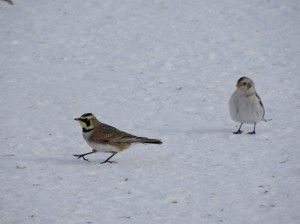April 28 2012. It was grasslands birds that I set out to see before the rest of the household was awake; I wanted to see if Upland Sandpipers had returned to a couple of spots I knew. They had; although they were hard to find at first. Later on when they’ve established territories they’re often easier to see standing atop a fence post or utility pole keeping watch. They are not particularly spectacular birds to look at; in fact as sandpipers go they’re a little gawky. But there’s something about the way they conduct themselves that makes them so endearing. Not all sandpipers are birds of shores and wetlands and the Upland Sandpiper is one of these exceptions, they like dryish grasslands where they walk around with their compact beady-eyed heads bobbing just above the vegetation tops. They have a bubbling widdy-wit widdy-wit call, heard as they fly overhead and an incredible wolf whistle of a song: “ToowlLEEEt –WhEEEELluuw” that it uses to proclaim its place on Earth; and then to top it off when it alights it briefly raises it wings, tip to tip, like a victorious marathon man.
The Upland Sandpipers were the best of the morning, and of the day, but in those few hours in the field there was much more that caught my attention. A Wilson’s Snipe was staking his claim by flying a high and looping display flight like a roller coaster, and with every slide downwards his wings made the weird winnowing sound, an ethereal rapid hoo-hoo-hoo-hoo-hoo-hoo-hoo. I could hear him clearly but it was only by scanning with my binoculars that I could see him. No doubt his beloved was watching enthralled and adoringly from the wet ground below. An Eastern Meadowlark sang from the tip of a scrubby hawthorn, his chest an astonishingly bright yellow with a black V-neck medallion. Savannah Sparrows were calling from grass stalks and a liquid trilling song had me baffled for a while until I spotted a vividly yellow-throated Horned Larkstumbling through grass clumps. Horned Larks either stay with us all year or are very early to return in mid winter when they like to mix in with Snow Buntings and Lapland Longspur flocks.

Then when the other spring showstoppers arrive the Horned Larks apparently fade into the background to start nesting on sparse wind-blown and snow-streaked fields. Today’s was a reminder that they’re still with us and are raising young too. (This picture was taken in January; note the seemingly astonished look on the Snow Bunting. Click on the picture for full sized version.)